| Columns Retired Columns & Blogs |
... a phono cartridge that is "loaded by a dead short"?

When I reviewed the Sentec, I owned three turntables and about 300 records. But phono stage–wise, I was a beggar and a borrower, hoping a friend's phono pre or some review product would jump out of the deck and become my reference. The Sentec was relaxed and natural sounding and fun to use, but it wasn't sharp, vigorous, or well-sorted. Unsatisfied, I kept my search going until the summer of 2016 when Art Dudley suggested I try Tavish Design's six-tube Adagio phono stage, which he had just reviewed in Listening #162.
With permission from Tavish founder and engineer Scott Reynolds, Art passed his Adagio review sample along to me. Right away, I liked its pro-style black faceplate and gray, painted-steel chassis. Its sound was balanced, not excessively tubey, and satisfying on every level I care about. But it was the Adagio's ability to let me connect two turntables and quickly and easily set all cartridge and amplifier operating parameters with faceplate-mounted switches that caused it to stay in my system for seven years and counting. That's a millennium in reviewer time.
In my mind, this "everything is front-panel adjustable" feature made phono preamps with hidden DIP-switches seem tourist-class. The Adagio introduced me to business class.
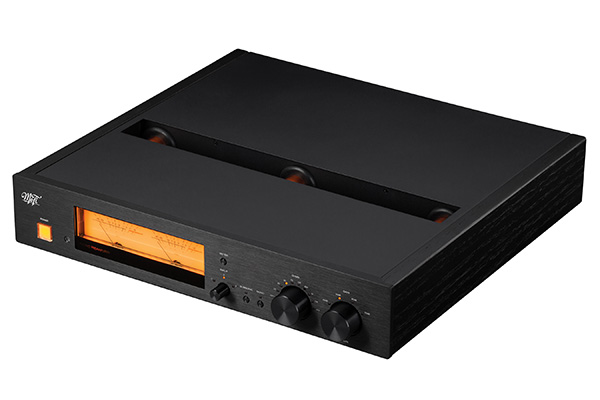
I first spotted Mobile Fidelity Electronics's $5999 MasterPhono MM/MC phono stage at AXPONA 2023. As intended, the red-orange lights on its VU meters caught my attention. So did its wood side panels—but it was the MasterPhono's extensive front-panel-adjustability I was thinking about when I requested a review sample.
The MasterPhono (footnote 1) measures 17" × 3.5" × 15.75" and weighs 15lb. On the front, one knob selects Gain: 40dB, 50dB, 60dB, or 70dB. The second knob chooses one of 10 (!) possible MC cartridge loads: 15, 30, 50, 75, 100, 500, 1k, 10k, 47k ohm, or "OPT," which allows users to use custom load values made via resistor-equipped RCA plug-ins. A high-pass/subsonic filter button sits between a mono button and a knob for dimming the meter display.
The MasterPhono consists of two bolted-together chassis: a front one for the power supply and control functions and a back one for audio amplification and passive RIAA filtering. The separate chassis are joined by wood side pieces and connected electrically via three shielded, wire-carrying conduits. MoFi design engineer Peter Madnick told me by email, "The MasterPhono has the noisy stuff in the front enclosure, analog processes in back.
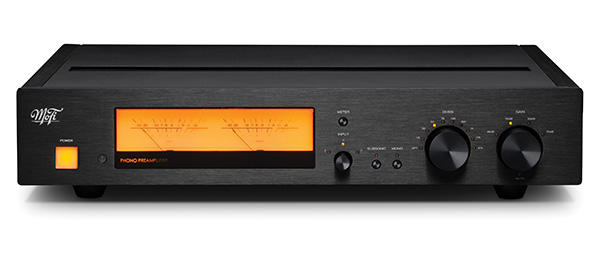
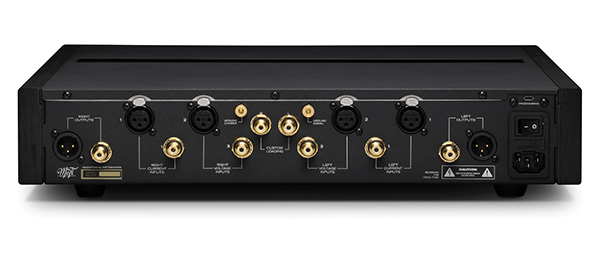
"In the front is the microcontroller board and the main power supply. In the rear audio circuit enclosure, the discrete JFET amplification and passive RIAA are separately housed within a temperature sensitive, shielded copper enclosure.
"The main power supply board has a tiny AC-to-DC 5V 'keep alive' supply, which runs the microcontroller whenever the rear AC power switch is ON and also powers the latching relays when it is time to switch any of them."
Peter seemed proud of how his "latching relays" operated, so I asked him to explain. "There are two general types of electromagnetic relays. The predominant style is called monostable, meaning they have one preferred rest state (call it the OPEN position), and when you apply current to the energizing coil, it fights the latching spring and pulls it closed. In order to remain closed, it must remain powered, consuming current just to continue to overcome the spring that wants to pull it open, and [that is] why they are called nonlatching. On the other hand, the bistable relays I use are comfortable resting in either their OPEN or CLOSED position because they have a kind of mechanical lock (the latch) which holds them in that position. Current is only required to flip it over to the opposite latched position. No current needs to flow to keep it in one spot or the other."
I told Peter I didn't realize that phono stages need relays or microprocessors, but I was sure they needed a quiet, well-regulated power supply. I encouraged him to talk about that. "The main operating voltages are generated by two 24V AC–DC converters. Their output is prefiltered by a choke and capacitor filter and feeds a pair of 22V preregulators prior to traveling through the chassis-to-chassis shield pipe to the audio boards in the back chassis. Note that all the capacitors are audio-grade, low-ESR types and are heavily bypassed with film caps.
"All told, there are 26 active power supply devices powering the audio stages; we reached the point of diminishing returns. If you can make it any quieter, I don't know how to do it."
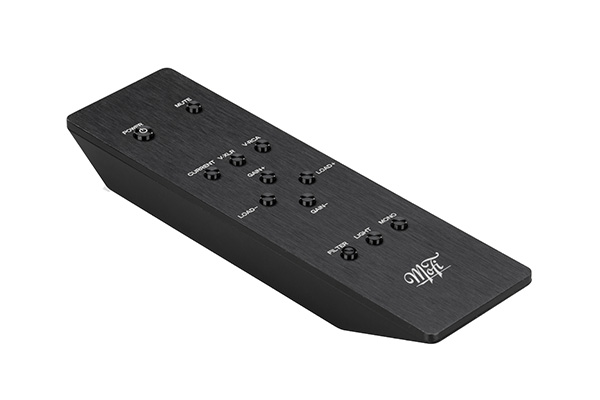
Use and setup
In operation, the MasterPhono's knobs and Power button have an unusual, floaty, unmechanical feel. Whenever I changed inputs, cartridge load, or gain, it felt like the knobs were not touching anything. There were no detents or clicking noises to indicate that the next position had been reached. Instead, after a moment, a light lit up over the new selection. Initially, I found this untethered feeling uncomfortable, but after a while I stopped noticing it.
The red-orange meter lights can be extinguished by a quick push of the Meter button or the Light button on the snazzy, sculpted-aluminum remote control, which duplicates the controls on the MasterPhono's front panel.
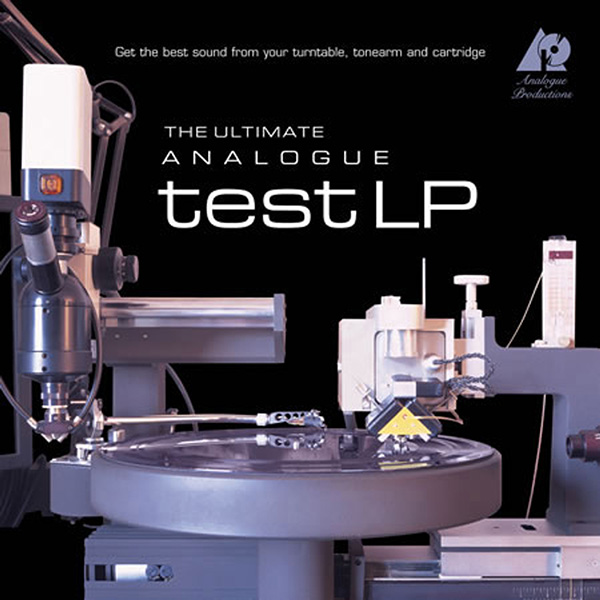
It's not mentioned in the owner's manual, but that Meter button serves other functions not usually found on a phono stage at this price level. Hold the Meter button down for a few seconds, and the INPUT 1 indicator light begins to blink. Now the MasterPhono is in TEST MODE 1, which allows users to calibrate the metering using the 1kHz tone on Side 1, Track 1 from Analogue Productions' Ultimate Analogue Test LP (AAPT1). This sets the correct level as "0dB."
Holding the Meter button down again moves the MasterPhono into TEST MODE 2. Here, using the –20dB, 1kHz tone on track #4 of AAPT1, the user can observe what happens when the test electrically subtracts the right channel signal from the left channel signal displaying the difference. Madnick says this is useful for adjusting azimuth. He's correct of course. This is accomplished by finding the cartridge azimuth setting that gives the lowest meter reading.
I tried TEST MODE 2 with every cartridge mentioned in this report, and it works. But a better method (I am told) is to use the left-right 1kHz tones on AP tracks #2 and #3 to measure crosstalk with an oscilloscope, or, like I do, with a Musical Surroundings Fozgometer, which sets azimuth by comparing the output of the unmodulated channel to the output of the modulated channel. The two approaches accomplish the same thing; both approaches helped me feel more confident about azimuth settings. Of the three methods, I prefer the needle-steady repeatability of the Fozgometer V2. Nevertheless, if you've never used a meter to adjust azimuth, the MasterPhono gives you a perfect way to start.
Holding down the Meter button one more time again moves the user into TEST MODE 3. "For now, this mode remains undefined," the online instructions say, "but will eventually be enabled via software update." Holding it down a fourth time puts the MasterPhono back into normal operation.
What I like most about the MasterPhono is its three inputs, selectable from the front panel: a regular single-ended RCA, a balanced XLR, and a transimpedance (current-drive) input that gives users a choice of either single-ended or balanced connection.
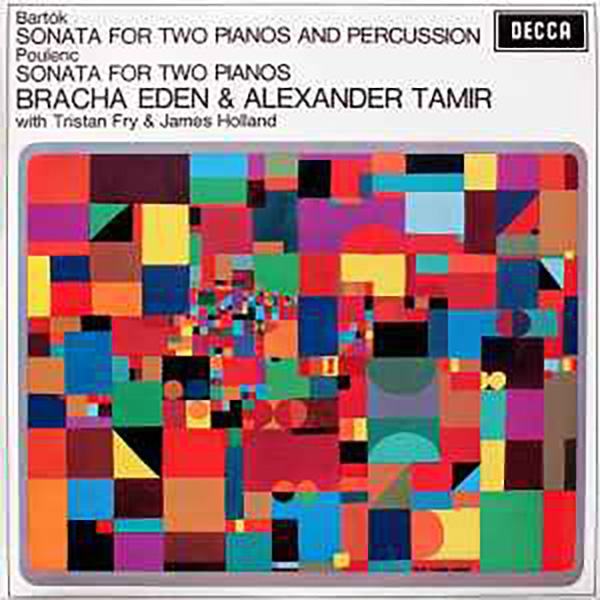
Listening
Don't ask me to explain this. The solid state MasterPhono took three full days to lose all the gray flatness it showed on the first day, just like the tubed PrimaLuna EVO 100 phono stage I reviewed in this space last month. When it finally lit up, its unusually bold dynamic contrasts made Bartók's Sonata for Two Pianos and Percussion, with pianists Tristan Fry and James Holland (White label LP, London CS 6583), into a succession of startling moments.
I was playing this exciting-sounding Bartók with EMT's JSD6 moving coil cartridge, loaded at 500 ohms. The tonearm was EMT's new 912, sporting a Cardas Clear Beyond tonearm cable. The sound was cloudless, big-sky expansive—unusually spacious for solid state, with at least 20% more depth and height at the back of the soundstage than I get from the all-tube PrimaLuna EVO 100. Bass was thunderous and lightning fast. Bartók's use of big drums, contrasting with little drums, felt perfectly expressed. The close-miked pianos tore through tempos like a storm on the prairie.
With the MasterPhono, this wild, stunning disc made me feel like I was the one pounding the piano. Piano sustain and percussive drum sounds were presented solidly, right there in front of me, with the Heretic AD614 speakers. Percussion transients were naturally sharp-sounding and dramatically impactful, but never hard, overemphasized, or compressed. This Bartók sonata was not as free-flowing supple or as colorful as it was with the PrimaLuna EVO 100, but it was unquestionably more dynamic and dramatic.
The Bartók sonata came through the MasterPhono with intoxicating levels of power and clarity, but that was nothing compared to the high-energy excitements of René Saorgin playing toccatas by Georg Muffat, from his composition Apparatus Musico-Organisticus, on the historic organ at Malaucene in Provence (Harmonia Mundi France HMU 966/967). This disc energized my room at average SPLs of 100dB and much higher (2m, C-weighted), with 112dB peaks that sounded so relaxed that I guessed it was playing at least 10dB lower than that. I checked the SPL with my dB meter because the low organ notes were shaking my easy-to-shake floor, and I wondered how much energy it took to make that happen. Loud organ music can be goosebump-thrilling, but only when it doesn't feel loud. With the EMT-MasterPhono combination, it didn't.
It's been a while since I heard anything more mind-grabbing than these four sides of Georg Muffat toccatas.

... a phono cartridge that is "loaded by a dead short"?

Test Mode is something that should come standard on all phono preamps. Future industry trickle-down hopes indeed!
Subsonic filter- for anyone with subs that don't have roll-off provisions.
I also like custom load options this way vs. a potentiometer a la PS Audio.
And current-drive? Yaaaas. I like this puppy, and it's pretty sexy lookin too.
And... more Herb, please!

This would be a fun toy.
Happy new year, Glotz!
Consider the Pacific Northwest Audiofest!
You’d be great to sip wine and chat with.
You are Chicago based?

I saw this days ago and forgot to respond.
Yep, Milwaukee but I frequent Chicago several times a year. I'd like to do the Pacific NW Audiofest. I'll look deeper at my finances this year. Maybe I can see a buddy in California as a two-fer?

Herb. I'd like to hear more about what seems to be your "lost" middle period. You know, after the wild young days of Mopar muscle and two-stroke smoke, after the New York Audio Mafia and importing esoteric hi-end gear but before finding yourself living in a tiny NY loft on the bones of your ass as a Stereophile cub reporter (as described above). Not necessarily right here, right now, but I'd still be interested. This is not a challenge, rather an invitation and a promise to read. Kind regards, Artie

if you remember I came to NYC in 1975 to become a famous artist, painter, sculptor, etc. but until recently, I supported myself (mostly) by practicing one or another of the various building and construction trades. In the 21st century I worked construction mostly with Komuro and Jeffrey Catalano of High Water Sound.
But I've always made Art– and told stories.
herb

from May/June 2001. It's a very nice and hilarious essay on jungle oats.
He buys them to 'kick his own ass'... LMAO.. I love it to the friggin core!
Does Herb have a little Kramer in him (or is it the other way around?) I'd like to think so.
I need to find those old Listeners lying around...

No one should ever be faulted for doing the things they love in spite of all the obstacles they have to deal with. Life often gets in the way of that at times.
The phono stage is to the cartridge as the microphone preamp is to the ultimate sound of any microphone. Have to be very good to sound great.
I also have to admit that I am enjoying the sound of Tidal HD. Didn't think I'd become a fan of streaming.